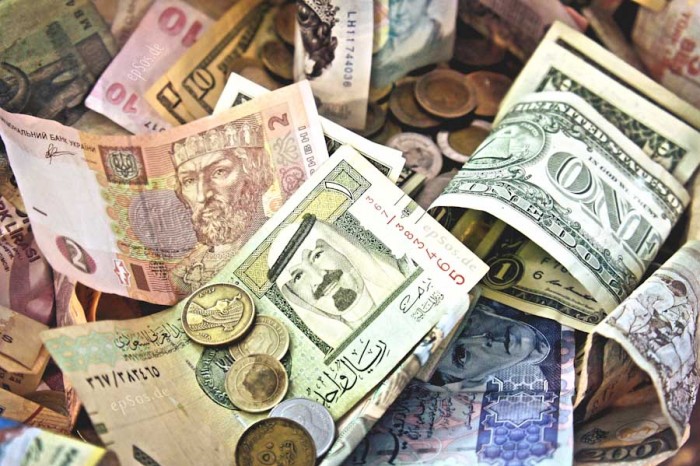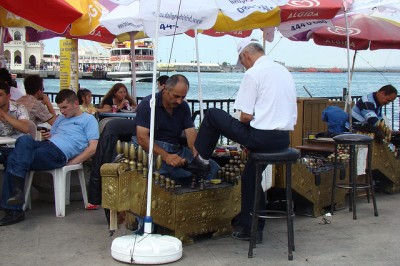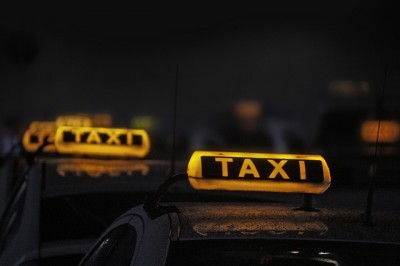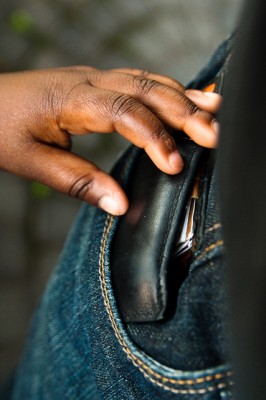
Falling victim to a scam feels bad, mostly because of how easily the situations could be avoided with a bit of foresight.
I’ve witnessed and been victim to many of these in my own limited travel experience — I guess I just look like an easy mark.
Here are some common scams that you should be aware of for your next trip abroad:
1. Sneaky Shoe Shiners

This scam is pretty well known to locals in Istanbul, but is pretty ubiquitous elsewhere too. An innocent looking shoe-shiner strolls casually along and drops a brush on the ground as he passes. It hits the pavement with a hard wooden clunk so that it is easily noticed by whichever friendly tourist is passing by.
Last winter this tourist was me, taking the bait as I stooped to the ground to retrieve his oily tool. Luckily I skimmed a poster describing popular scams at my hostel and remembered how the act was supposed to play out as I handed back his brush. He thanked me repeatedly and with a grand gesture whipped out his shoe-shining kit and beckoned to me, as if to thank me with a free shining.
If I accept his offer, I know the grand finale is an inflated price for a service that appeared to be free. Refusing to pay may then result in one or more “colleagues” appearing to support the sneaky shoe shiner, they’re likely to cause a scene.
In general, be wary of anybody trying to offer you something for free, as this strategy comes into play for many minor scams (e.g. the “friendship bracelet”). Don’t worry, you’ll know real hospitality when you find it.
2. Exchange Rate Rip-Offs
Some currencies can get confusing if you’re used to handling nothing higher than triple digit bills. My troubles began in Budapest, where one U.S. dollar gets you about 220 Hungarian forints (Hungary still holds the record for the largest currency denomination ever printed, a 100 quintillion pengo banknote was produced in 1946 as a result of post-WWII hyperinflation).
Restaurants, bars and clubs all capitalize on tourists that aren’t quite sure of the conversion rates, occasionally boosting bills for those who look gullible enough. If the receipt shows a total that is one decimal point further to the right than you expected, don’t hesitate to complain. Smartphone users should probably just go ahead and grab a currency convertor app to always be sure.
3. Cabbie Confusion

Any taxi that doesn’t have a meter carries the risk of a driver that might be looking to make an extra buck. I became privy to this shortly after my first cab ride from the train station in Sarajevo. After comparing prices between two groups that had taken the same route to the same destination, we found that one driver charged double the price of the other.
It’s best to do some research on average taxi rates in whichever country you visit. With this knowledge in hand you can set a price point from the start of your trip instead of haggling at the end. In some cities taxis may also set both night rates and day rates, and charging tourists with the higher night rate during the day is sometimes just too easy.
Most taxi drivers won’t resort to these underhanded dealings, and often they can provide a wealth of insider information on what’s happening in their cities. Ask them about their favorite streets and neighborhoods, they’ll know more than most.
4. Designer Leather Dupe
A con that began in Italy may be crossing borders. I haven’t experienced this one myself but Seattle resident Alvin Wong recently encountered a variation of the jacket salesman in distress.
He described to me a man sitting in a van that asked him if he knew Armani, the Italian leather brand. Alvin answers yes and the man launches into a story about rushing to catch a flight in a couple hours and being locked out of his bank accounts. He offers to sell Alvin a stack of Armani leather jackets for a fraction of the retail price. He even offers to drive to the nearest ATM to complete this incredible deal. Spoiler alert: the jackets are always fake.
5. The Classic

First comes a distraction, next comes a pickpocket. It’s one of the oldest tricks in the thief’s handbook and it can be easy to fall victim to, especially if you’ve had one too many drinks that night.
On one such night in Rome I was pick-pocketed for the first time while walking back to my apartment. Like most people, I thought I was smart enough to avoid being robbed in plain sight. As I crossed a bridge over the river, a group of nighttime revelers danced around me, one embracing me in what I assumed to be a drunken show of indiscriminate affection.
He wrapped a leg around me and we spun into a clumsy jig. I laughed it off until I reached the other side of the bridge without my phone in my pocket.
My only advice here is to never let anybody touch you. Or just avoid late night dances with strangers. Your call.
While the aforementioned scams can sometimes prove problematic, the real problem with scams is the general suspicion that they generate among visitors. Genuine experiences and interactions with locals are harder to come by if travelers feel they must be wary of every friendly gesture.
Remember that there are always more friendly locals than people trying to take advantage of you; the odds are forever in your favor.


1 Comment
Comments are closed.